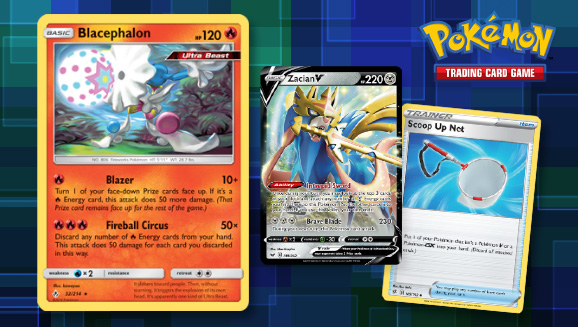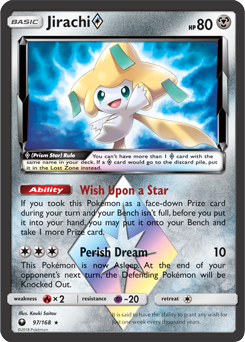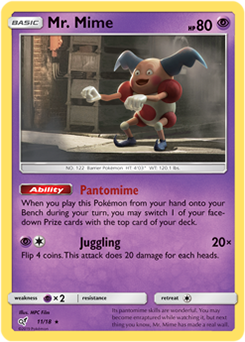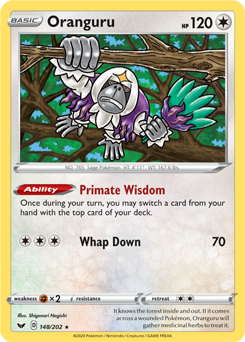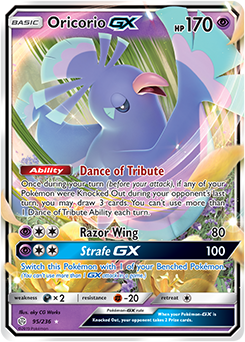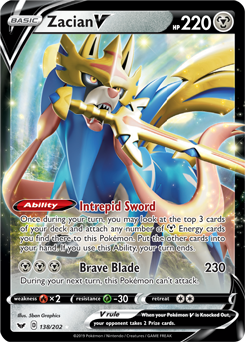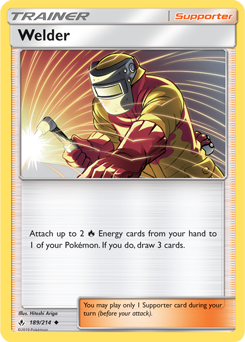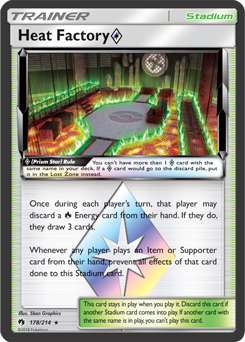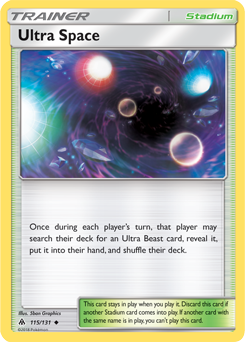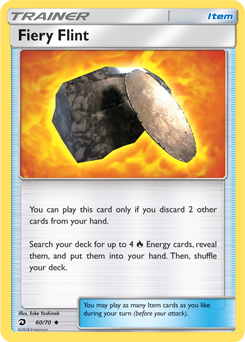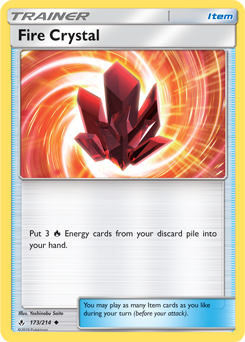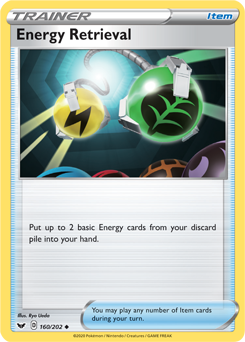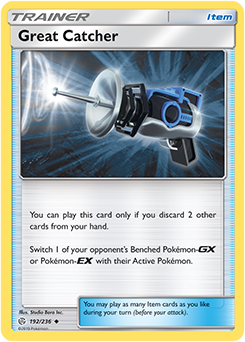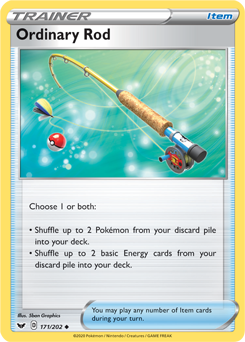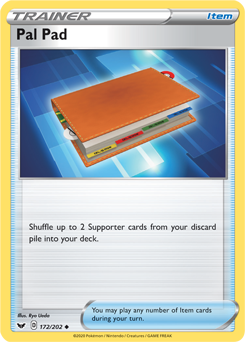By Stéphane Ivanoff, Contributing Writer
Look at some of the best Pokémon TCG decks around today: Pikachu & Zekrom-GX, Arceus & Dialga & Palkia-GX plus Zacian V, Dragapult VMAX... What do they have in common? They all use Pokémon-GX or Pokémon V as their main attackers—that is, Pokémon that give up more than one Prize card when they’re Knocked Out. With their massive HP, these Pokémon can take several hits from smaller Pokémon and last longer, significantly offsetting this drawback.
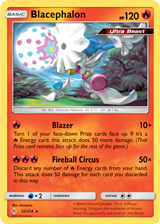
But what if there was a Pokémon that only gave up one Prize card when Knocked Out, but that still had the power to Knock Out any Pokémon in one hit? Such a Pokémon would have a huge advantage in the Prize-card race. That Pokémon exists: Blacephalon. Without relying on Weakness, Blacephalon can take down any Pokémon with its Fireball Circus attack—as long as you have enough Energy in hand.
Building a deck in a way that allows you to use Fireball Circus every turn is a challenge, but as a Blacephalon expert, I’m here to show you what such a deck looks like and how to play it! And even if you’re already familiar with this archetype, keep reading: Sword & Shield—Rebel Clash brought the deck some new and unique tricks!
The Basics
Blacephalon needs 3 Fire Energy to use Fireball Circus. This means it can be powered up in one turn by attaching your Energy for the turn, and then attaching two more with Welder, which also draws cards. Since Blacephalon has only 120 HP, we should prepare for the worst and assume that it will be Knocked Out in one hit after attacking. This means we want to charge up a new Blacephalon every turn, so Welder is the only Supporter we want to play in the deck. Playing only Welder is not a new concept; other decks, such as Fire Toolbox and Mewtwo & Mew-GX, also include no Supporters other than four copies of Welder.
Where Blacephalon differs from these decks is that our main Pokémon needs us to have Energy in hand, not just in play. We need more ways to find Fire Energy every turn, and this is achieved thanks to three key Item cards: Fiery Flint, Fire Crystal, and Energy Retrieval.
Blacephalon has been around for a bit: it was released in Sun & Moon—Unbroken Bonds, and Nathaniel Kaplan used it to make Top 4 at last year’s North America International Championships. Since then, the deck has gone through a few changes as players experimented with various draw engines. Early in the season, Blacephalon was paired either with Pidgeotto, whose Ability lets you draw cards every turn; or with Green’s Exploration, which could search up specific Trainer cards, including Beast Ring for another way to power up Blacephalon.
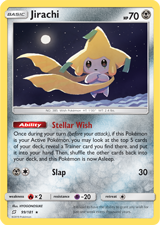
However, opinions have shifted, and many agree that the most effective way to draw your key Trainer cards right now is by using powerful Abilities on Basic Pokémon. Jirachi’s Stellar Wish is perhaps the best one, allowing us to dig for a Trainer card. Oricorio-GX’s Dance of Tribute can draw three cards every turn after one of our Pokémon gets Knocked Out. And Zacian V’s Intrepid Sword can also be used to draw cards in the early turns, before we start attacking. Finally, any deck that’s full of Fire Energy benefits from Heat Factory Prism Star.
With those cards in mind, here is my current list for this deck. I’m excited to try it once tournaments resume, but for now I’ve had a lot of success online with it!
How to Play Blacephalon
We’ve gone over the fundamentals of this deck: attach Fire Energy to Blacephalon, use Fireball Circus, and repeat. As far as game plans go, Blacephalon’s is pretty linear. However, there are two important concepts to know in order to master the deck: sequencing and Prize planning.
Sequencing
Sequencing is the science of playing your cards or using Abilities in the right order to maximize your odds of accomplishing your goal for the turn (which, in this deck, is almost always to Knock Out the opponent’s Active Pokémon). Since getting Fire Energy into your hand is the most important element of your strategy, you should play cards in the optimal order to accomplish this.
For example, you should play Fiery Flint before using Jirachi’s Stellar Wish: that way, you remove four Energy cards from your deck, increasing your odds of getting a Trainer card you want with Stellar Wish. To stretch this even further, the best order to use your various ways to draw in one turn is usually: Dance of Tribute, followed by Welder, then Heat Factory Prism Star, and finally Stellar Wish. Drawing cards before using Stellar Wish lets you dig deeper into your deck and select a Trainer card knowing all the other cards in your hand. There are exceptions to this pattern, of course. Let’s say you need to draw your deck’s last Energy cards: you should use Stellar Wish first (and then Ordinary Rod if you have it!), and only then use Dance of Tribute and your other ways to draw cards.
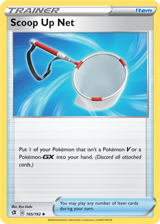
Sequencing is important in less obvious ways, as well. This deck uses Scoop Up Net, but I’m very careful with how I use it. Scoop Up Net is an interesting card that works very well with Jirachi but makes sequencing harder. Let’s say your Blacephalon just got Knocked Out, and you need to use Stellar Wish as many times as possible on your turn. You have two Jirachi already in play, one with an Escape Board attached. You also have a Scoop Up Net and a Switch in hand. Because your Blacephalon just got Knocked Out, you need to promote one of the Jirachi to the Active Spot. What do you do?
If your first move is to promote the Jirachi with Escape Board, you’d be making a mistake! While it’s a natural instinct to bring up a Pokémon that has no Retreat Cost, it’s incorrect in this specific case. Instead, promote the other Jirachi. After using Stellar Wish, use Scoop Up Net, send the Jirachi with Escape Board to the Active Spot, and use its own Stellar Wish. Then, play the Jirachi you scooped up, retreat your Active Jirachi, and send this one forward. Since you just played this Jirachi, it’s a new Pokémon, and you can use Stellar Wish—for the third time in the turn! Finally, assuming you managed to get a Blacephalon ready to attack, you can play Switch to move it to the Active Spot.
Remember, sequencing is about having a goal in mind for that turn and determining the order of cards you can play to achieve that goal. It’s a fundamental element of Pokémon TCG strategy that will help you improve your game immensely.
Prize Planning
If sequencing is the way you play out one specific turn, Prize planning is a similar thing on a longer time scale: it’s knowing in advance how you’re going to take all six Prize cards in the fastest way possible and win the game. Unlike with other decks, you can’t really choose your targets with Boss’s Orders or Custom Catcher when you’re playing Blacephalon. Most of the time, you’re going to attack whatever Pokémon your opponent has Active. However, there are three ways to claim more Prize cards than your opponent is offering.
The first is Great Catcher, which is usually played in the late game. If you have only two Prize cards left to take, but your opponent’s Active Pokémon is tough to Knock Out (for example a TAG TEAM Pokémon-GX or a Pokémon VMAX), you can play Great Catcher to have them bring up a slightly easier target. Conversely, you can also play Great Catcher when your opponent’s Active Pokémon only gives up one Prize card, in order to bring up a Pokémon-GX and take more Prize cards in one turn.
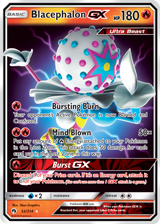
The second is Blacephalon-GX’s Burst-GX attack, which is just about the easiest way to get rid of a single Prize card. This attack is best kept for the late game because it’s much easier to set up than Fireball Circus (you don’t even need Welder!), and especially since your opponent might play a Reset Stamp to make it harder to power up your Blacephalon.
Finally, this deck uses a rather complex combination of Oranguru, Mr. Mime, and Jirachi Prism Star. It works like this: Use Oranguru’s Primate Wisdom to put Jirachi Prism Star on top of your deck (and draw another card in exchange). Then, play Mr. Mime and use its Pantomime Ability to swap Jirachi Prism Star with one of your Prize cards. The next time you get a Knock Out, if you have space on your Bench, take Jirachi Prism Star (since you’ll know where it is in your Prize cards), and you’ll get to take an extra Prize card thanks to its Wish Upon a Star Ability!
It may look complicated, but the benefits of such a combination are huge. Taking one extra Prize card can often mean winning a game that you’d have lost otherwise. It means you can win a game in only two attacks by Knocking Out a three-Prize and a two-Prize Pokémon, something that happens pretty often.
Scoop Up Net helps this combination a lot, for two reasons. It can be used to free up space on the Bench to make sure you can play Mr. Mime and Jirachi Prism Star. And in longer games, you can even get these two cards back in your hand in order to use the combination a second time and get another free Prize card!
While you can’t predict everything that will happen at the start of a game, when you understand what kind of deck your opponent is playing, you should have an idea of how you’re going to take all your Prize cards, and how many turns it will take to do so. Here’s what your games might look like against some of the most popular decks in the format:
Against Dragapult VMAX
This deck uses only Dragapult VMAX as an attacker, so you can win in two attacks by Knocking Out two Dragapult VMAX. That’s not so easy to do because of Dragapult VMAX’s massive HP! The game gets easier if your opponent has to play Dedenne-GX, a prime target for Great Catcher. In this scenario, you can win by Knocking Out Dragapult VMAX and Dedenne-GX, then ending the game with Blacephalon-GX’s Burst-GX attack, or even taking three Prize cards for Dragapult VMAX and three for Dedenne-GX thanks to Jirachi Prism Star. Alternatively, if you can get an early Knock Out on a Jirachi on the first or second turn, then you could use Burst-GX for another Prize card, and finish the game by taking four Prize cards when you Knock Out Dragapult VMAX, thanks to Jirachi Prism Star.
Against Arceus & Dialga & Palkia-GX / Zacian V
This deck starts slow and doesn’t do damage until turn three, but once it starts attacking, it takes Prize cards twice as quickly: a Knock Out on Blacephalon will give your opponent two Prize cards instead of one thanks to Altered Creation-GX! Fortunately, Blacephalon tends to win this race, although it’s a close one. Once Altered Creation-GX has been used, your opponent needs only three turns to win the game, so you need to be faster. If you can get a Knock Out with Fireball Circus on Arceus & Dialga & Palkia-GX before it can use Ultimate Ray, then you’ll be in a great position! You can win the game in two turns by Knocking Out the subsequent Zacian V and finally using Burst-GX. Be careful, though: don’t put more than one Pokémon-GX or Pokémon V into play if you can avoid it! If you have two two-Prize Pokémon on your Bench, then your opponent will have the opportunity to win in two turns by Knocking Out both of them.
Against Pikachu & Zekrom-GX
Lists of this deck can differ quite a bit and use a variety of secondary attackers. But they always start their offensive by using Pikachu & Zekrom-GX’s Full Blitz, and most of their attackers are Pokémon-GX or Pokémon V. The easiest road to victory is to get three Prize cards with a single Knock Out of Pikachu & Zekrom-GX, then two more Prize cards by Knocking Out the follow-up attacker, and the last one by using Burst-GX. Compared to Arceus & Dialga & Palkia-GX, Pikachu & Zekrom-GX can take Prize cards earlier, but since it can’t take extra Prize cards per Knock Out, it doesn’t win as fast. Sometimes you’ll need to sacrifice a couple of Pokémon while you set up, but you should be able to catch up. Be aware that Pikachu & Zekrom-GX’s Tag Bolt-GX can take multiple Knock Outs in one turn. If you’re having trouble beating this deck, you can include Mew in your list to protect yourself against it.
Against Other Blacephalon Decks
This matchup tends to be a back-and-forth where each player takes a Prize card per turn. This means Jirachi Prism Star is very important here: one additional Prize card means you’re one whole turn closer to victory. Be careful with your resources, and don’t discard too many Energy cards to Quick Ball, Heat Factory Prism Star, or Fiery Flint, since you’ll need a lot of them throughout the game. Keep Ordinary Rod to get back Blacephalon and some Fire Energy in the late game so you don’t run out of attackers, and target your opponent’s Oricorio-GX with Great Catcher as soon as it hits the Bench. You should use Burst-GX to take your last Prize card, but don’t put Blacephalon-GX on your Bench before that, since it gives up two Prize cards.
Blacephalon’s Weaknesses
While Blacephalon is a very powerful deck, it’s not without its shortcomings. Here are some cards and strategies to watch out for—or, if you’re struggling to beat Blacephalon, here are some ideas you could adopt!
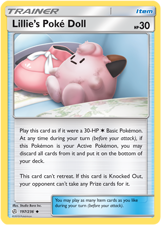
First, Blacephalon struggles against mill and control decks that hide behind Lillie’s Poké Doll and either discard cards from your deck aggressively with Bellelba & Brycen-Man, or discard your Energy and your hand in order to control the game. Since this deck doesn’t have a universal way to attack Pokémon on the opponent’s Bench, there just isn’t much we can do against these strategies.
A much more common challenge to this deck is hand disruption. Picture this: you played your first turn, you have a Jirachi, a Blacephalon, a Zacian V, and you just used Intrepid Sword, getting a Welder for next turn...and your opponent uses Marnie, putting you back to four cards in hand. It’s only a minor setback, but in a close game, losing a turn in this way could be decisive. Other opponents will use Reset Stamp instead: it’s much less effective in the early game, but it can be devastating in the late game. The best way to protect yourself against Reset Stamp is to have Oricorio-GX in play, so if your opponent Knocks Out Blacephalon, you can get more cards to get another one ready to attack. (And, if they Knock Out Oricorio-GX instead, at least you still have your powered-up Blacephalon, and you only need to get Energy to discard!)
Finally, beware of Tapu Fini, which can Knock Out Blacephalon for a single Energy. It can be used by decks that use mostly Pokémon-GX or Pokémon V to attack, giving them an easy way to Knock Out Blacephalon with a Pokémon that only gives up one Prize card. It’s especially effective in Arceus & Dialga & Palkia-GX decks, since Tapu Fini will take two Prizes when it attacks but only gives up one!
Blacephalon is a deck that I’ve had a lot of success with this season. It’s an easy deck to understand, but not as easy to master. However, I hope this guide helped you understand its intricacies. I find that there’s something profoundly enjoyable about choosing the best way to play a complicated hand, drawing a bunch of cards in one turn, and finally discarding six Fire Energy to take three Prize cards in one turn by Knocking Out a much bigger Pokémon in one hit. If that kind of play appeals to you as well, don’t wait any longer—join the Fireball Circus!
For more Pokémon TCG tips and analysis, be sure to check out Pokemon.co.uk/Strategy.
 Stéphane Ivanoff
Stéphane Ivanoff
Stéphane Ivanoff is a contributing writer for Pokemon.com. A longtime Pokémon fan, he has played the Pokémon TCG competitively since 2010 and is a former National Champion, seven-time Worlds competitor, and the 2018 and 2019 North America International Champion in the Masters Division. He studied mathematics and has a degree in probability and statistics, but he says that doesn’t help his game as much as you’d think! You can follow him on Twitter @lubyllule.
